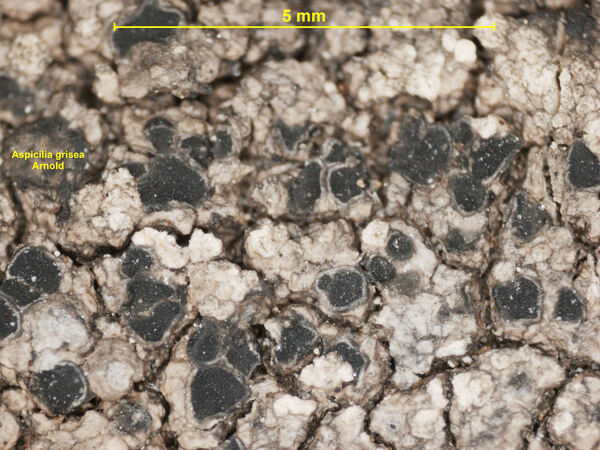Aspicilia grisea Arnold
Ber. bayer. bot. Ges., 1: 62, 1891.
Synonyms: Aspicilia insolata (H. Magn.) Hav.; Lecanora grisea (Arnold) Lettau non Ach.; Lecanora griseolans Zahlbr.; Lecanora insolata H. Magn.
Description: Thallus crustose, episubstratic, rather thin, continuous to rimose-areolate, grey, dark grey to almost black, sometimes delimited by a dark prothallus. Areoles flat to slightly convex, often rounded, 0.3-1 mm wide, bearing punctiform to orbicular, 0.2-0.8 mm wide, flat, yellowish white to ochre, rarely finally grey, often abraded soralia with farinose soredia (50-80 μm diam.), which sometimes develop shiny black tips and resemble isidia. Apothecia rare, lecanorine-aspicilioid, immersed in the thallus, 0.3-0.6 mm across, with a black, epruinose disc and a thin thalline margin; proper margin well-developed. Epithecium olive-green, N+ emerald green; hymenium colourless; paraphyses sparingly branched, moniliform in upper part, the apical cell to c. 3 μm wide. Asci 8-spored, clavate, the thin outer coat K/I+ blue, the wall and apical dome K/I-. Ascospores 1-celled, hyaline, ellipsoid, 18-26 x 9-15 μm. Photobiont chlorococcoid. Spot tests: thallus K+ yellow turning red (needle-like crystals), more rarely K+ persistently yellow, C-, KC-, P+ bright to golden yellow. Chemistry: norstictic acid, more rarely stictic acid as a major substance.
Growth form: Crustose
Substrata: rocks
Photobiont: green algae other than Trentepohlia
Reproductive strategy: mainly asexual, by soredia, or soredia-like structures (e.g. blastidia)
Pioneer species
Commonnes-rarity: (info)
Alpine belt: rare
Subalpine belt: rather rare
Montane belt: very rare
Dry submediterranean belt: absent
Humid submediterranean belt: absent
Padanian area: absent
pH of the substrata:
1 2 3 4 5
Solar irradiation:
1 2 3 4 5
Aridity:
1 2 3 4 5
Eutrophication:
1 2 3 4 5
Poleotolerance:
0 1 2 3
Altitudinal distribution:
1 2 3 4 5 6
Rarity
absent
extremely rare
very rare
rare
rather rare
rather common
common
very common
extremely common
Loading data...
Occurrence data
Predictive map
Growth form: Crustose
Substrata: rocks
Photobiont: green algae other than Trentepohlia
Reproductive strategy: mainly asexual, by soredia, or soredia-like structures (e.g. blastidia)
Pioneer species
Commonnes-rarity: (info)
Alpine belt: rare
Subalpine belt: rather rare
Montane belt: very rare
Dry submediterranean belt: absent
Humid submediterranean belt: absent
Padanian area: absent
pH of the substrata:
| 1 | 2 | 3 | 4 | 5 |
Solar irradiation:
| 1 | 2 | 3 | 4 | 5 |
Aridity:
| 1 | 2 | 3 | 4 | 5 |
Eutrophication:
| 1 | 2 | 3 | 4 | 5 |
Poleotolerance:
| 0 | 1 | 2 | 3 |
Altitudinal distribution:
| 1 | 2 | 3 | 4 | 5 | 6 |
Rarity
absent
extremely rare
very rare
rare
rather rare
rather common
common
very common
extremely common
Loading data...
Occurrence data
Predictive map







